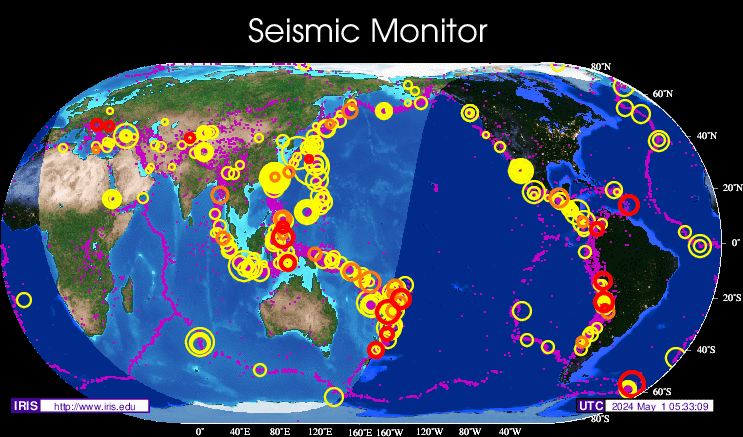Why this blog?
Until this moment I have been forced to listen while media and politicians alike have told me "what Canadians think". In all that time they never once asked.
This is just the voice of an ordinary Canadian yelling back at the radio -
"You don't speak for me."
email Kate
Goes to a private
mailserver in Europe.
I can't answer or use every tip, but all are appreciated!


Katewerk Art
Support SDA
Paypal:
Etransfers:
katewerk(at)sasktel.net
Not a registered charity.
I cannot issue tax receipts
Favourites/Resources
Instapundit
The Federalist
Powerline Blog
Babylon Bee
American Thinker
Legal Insurrection
Mark Steyn
American Greatness
Google Newspaper Archive
Pipeline Online
David Thompson
Podcasts
Steve Bannon's War Room
Scott Adams
Dark Horse
Michael Malice
Timcast
@Social
@Andy Ngo
@Cernovich
@Jack Posobeic
@IanMilesCheong
@AlinaChan
@YuriDeigin
@GlenGreenwald
@MattTaibbi
Support Our Advertisers

Sweetwater

Polar Bear Evolution

Email the Author
Wind Rain Temp

Seismic Map

What They Say About SDA
"Smalldeadanimals doesn't speak for the people of Saskatchewan" - Former Sask Premier Lorne Calvert
"I got so much traffic after your post my web host asked me to buy a larger traffic allowance." - Dr.Ross McKitrick
Holy hell, woman. When you send someone traffic, you send someone TRAFFIC.My hosting provider thought I was being DDoSed. - Sean McCormick
"The New York Times link to me yesterday [...] generated one-fifth of the traffic I normally get from a link from Small Dead Animals." - Kathy Shaidle
"You may be a nasty right winger, but you're not nasty all the time!" - Warren Kinsella
"Go back to collecting your welfare livelihood. - "Michael E. Zilkowsky
Yikes!
1. Add to this a chart on the value of the U.S. dollar.
2. Realize that this chart is not inflation adjusted.
3. Put on your brown pants.*
Note*: Some of you may want to perform step 3 first. Sorry.
Americans have slightly less disposable income on average… Yeah, so what? That chart has no effect on my regularity, whether it’s adjusted for inflation or not.
Infinity, you are my new hero. I mean that in a coffee-out-the-nose, wipe-the-computer-screen-while-giggling sort of way.
“So what?”
For a liberal to care this chart, it would have to be entitled: Real Disposable Personal Income For Minorities. Then it would be big. And then, only if Bush was still in power. But he’s not, so nevermind.
If Americans have slightly less money to spend on booze, lotto, smokes, bling, fast food or cheap disposable crap from MalWart, why should I care?
The big slowdown or mini crash is coming. We have already been told:
“Great job on last year, but no merit raises this year, and no bonuses next year. 2012 will be a very tough year for (our company).”
Good point, because you’re political brethren south of the border get all those things paid for with their EBT cards, food stamps and/or work for the government, shielded from economic woes. I see what you’re saying.
So where does it go from here? Up, down or sideways?
Hard to say for sure. We live in very uncertain times.
This is an election year in the US, which means an expanding economy. Remember in 09 and 10 when economists praised Harper for getting all that stimulus spend out into the economy quickly. Obama by comparison allocated 100’s of billions, but did not spend it then. Why? When is it to be spent? … This is an election year in the US.
ehtu? as usual manages to miss the point. Here’s the kicker. That’s the best this chart is ever going to look. The US is on a downward spiral with respect to sovereign debt. The spiralling debt problem can be solved in only one of four ways.
1. Do as was done in the past and grow its way out of debt burdens. This isn’t possible now. The US is on at least a medium and possibly long term track of average growth of 3% or less.
2. Slash government spending. However given that the bulk of the increases in US debt are occurring in health care and social security, even wiping out the military budget entirely will not eliminate the structural deficit.
3. Increased taxation. There’s inevitably going to be a lot of this, probably in the form of a VAT. The US is the only modern nation in the world which doesn’t have one. Problem is that it’s going to further depress growth.
4. Inflate the US currency. Essentially this means making the average US citizen take a cut in wages equivalent to the inflation rate. Anyone not on a defined benefits pension gets crushed.
The short conclusion is that this chart looks very, very good compared to what’s coming.
Now what ehtu? wants is for a redistribution of wealth from the so-called 1 per cent to the 99 per cent. What he doesn’t realize is that this so-called wealth amounts to trying to fill a bathtub with one thimble of water.
What he doesn’t seem to realize is that 52 per cent of all US citizens pay no federal income tax. In short, the 48 per cent of tax payers can no longer afford the drain on the system posed by the other 52 per cent. And none of his redistribution schemes will fix that. They will only accelerate the decline.
Gord, the short answer is that things are going to continue to decline until the US has deleveraged from at least half its present national debt AND funded all of its future unfunded liabilities, which currently are much larger than its current debt load.
If Americans have slightly less money to spend on booze, lotto, smokes, bling, fast food or cheap disposable crap from MalWart, why should I care?Posted by: North of 60
American can’t buy stuff … then … China can sell cheap crap Canada can’t sell booze – Seagrams – Molson etc … fast food … Tim Hortons etc. … the … Canada can’t sell China and the USA raw materials …then … Canadians lose jobs and prosperity. That’s why you should care. I should not have had to explain that to you. All dots connect eventually …
Perhaps you have stumbled onto a website you aren’t prepared for?
This chart definitely belongs in the “Is there nothing Obama can’t do” category.
Nice graph. The kind of thing we used to do in Gr.8. US per capita income has increased from about 60 somethings in 1979 to over 100 whatsits today. Whoopee!
Canadians lose jobs and prosperity. Canada can’t sell China and the USA raw materials
Bullfudge.
The graph shows that there has been very little change since about 2005. Such small changes in American disposable income have little to do with Canadian exports to China, or the US. Some people should pay attention and learn how to connect the dots, since they obviously can’t read graphs.
If you go here (as a good example.)
http://www.minneapolisfed.org/index.cfm
you will be able to calculate the dollars buying power in terms of goods and services. Compare 1979 to 2012. You should find that $1.00 is now $3.20.
Adjusting the chart for inflation suggests that today’s disposable income, relative to 1979, would be indexed at 31.5 on the y or vertical axis. That’s well below 50, where the chart starts.
The debt is huge, and there is appreciably less disposable income. Result: STAGFLATION
Tanx Lisa, I try. 😉
The average US consumer won’t want to go without those life’s little extras for long. So they will borrow, borrow, and borrow when they can. Couple that with existing student loans for useless degree’s, no real jobs, less funding to keep the welfare “youth” fed and off the streets, and it won’t be long until the entitlement generation decides to just take a little for themselves.
Yes, I agree with Kate. It’s probably nothing.
After all, there isn’t a single Canadian job that depends on the US economy. Not one Canadian job is based on exports to the US. Not one Canadian job is based on tourists from the US coming here. Not one Canadian job has ever been created by US investment here. Why would anyone think that Canada would be affected by the biggest decline in US per capita income since the Great Depression?
I mean, it’s not like US companies are closing plants here. It’s not like US gasoline consumption has fallen off a cliff; after all, we can always export the oil to China if that were to happen. It’s not like Americans living on unemployment and food stamps won’t be buying brand new Blackberries. All is well.
As I walk the frozen tundra north of 60, I haven’t a care in the world. Though the wind is cold, I see the shining sun, for I have connected the dots, and they form a giant Smiley face.
Or, possibly, not.
Obviously the fact that the graph shows no significant change in real disposable income for average Americans in the past seven years was difficult for some to grasp. Perhaps some Americans are choosing to spend their real disposable income at home.
Meanwhile Canadian Exports to America continue to grow.
Crude oil … US$20 billion, up 85.4% (17.5% of Canadian exports to U.S.)
Natural gas … $6.9 billion, up 6.4% (6%)
Petroleum excluding light oils … $3.4 billion, up 90.8% (3%)
Light oils … $2.2 billion, up 75.9% (1.9%)
Potassium chloride … $1.4 billion, up 81.3% (1.2%)
Medications excluding vaccines … $1.3 billion, down 16.4% (1.1%)
Non-monetary gold … $1.2 billion, up 83.5% (1%)
Coniferous wood … $1.18 billion, up 59.5% (1%).
Don’t let those facts get in the way of any preconceived ideas.
There’s nothing like a mass of figures given without any points of reference.
Up from… when? Last week? Last month? Last decade?
$ of what – current dollars? constant dollars? Dollars indexed to some specific point in time?
and of course – “$”? US$? CAD$? AUS$?
Without specifications, figures such as those posted are virtually meaningless.
Notwithstanding the rosy picture painted above, from 2005 to 2010, total Cdn tangible exports to the US from all sources FELL from $265 billion to $246 billion, measured in current US$. (Note: tangible here means raw and finished materials, food, etc. – it does not include the export of services.)
US trade with Canada and Mexico
A 9% absolute decline in exports to our largest trading partner over 5 years? And, since this is measured in current US dollars, it masks the fact that the CAD$ rose from $1.22 CAD/US in 2005 to near parity in 2010, meaning in constant CAD$, the drop is closer to 30%. Oh, ya – it’s probably nothing.
Kevin, two thoughts occur to me from your last post. The first is that such a drop would have meant a disaster for Canada’s economy 15 years ago when our export went about 85% to the US instead of the 75-8% that is the case today. That we survived the 2008 recession in better shape than the US may be in some small part due to the small realignment of Canadian export patterns to Asia.
The second thought is that the US has been following a low dollar currency policy for about 10 years now. Essentially they’ve been trying to export deflation to the rest of the world. In short, they’ve been waging an undeclared trade war against everyone. (Which leads in turn to an interesting question, how much of China’s currency distortions are created by US monetary policy?) If we expressed your numbers in CAD we might see this deflation export much more clearly.
And you’re right, a 30 per cent drop in five years is very far from nothing. What it means is even greater urgency to diversify our trading patterns away from a single market and to build the infrastructure in which to do so. Northern Gateway is indeed a ‘must-have’ asset. As is the uranium sales agreement with China this week.
cgh:
The US dollar index has been declining for years. Here’s a link to a chart:
US dollar index (Note: adjust the dates from Jan 1980 to Feb 2012 to see what I mean. The US dollar had an enormous resurgence during Reagan’s first term, from 80 to 160, and has since fallen all the way back, with a brief interruption in the early ‘aughts.)
So I completely agree that Canada needs to diversify its exports from a crumbling US and an imploding Europe to an expanding Asia. My local Tory MP recently solicited my views on the upcoming budget, and I identified trade diversification as the number one challenge facing Canada.
But in the short term, Canada’s growth is going to be held back by the US problems, which was the point I was trying to make to our nonchalant if frozen friend from the territories.